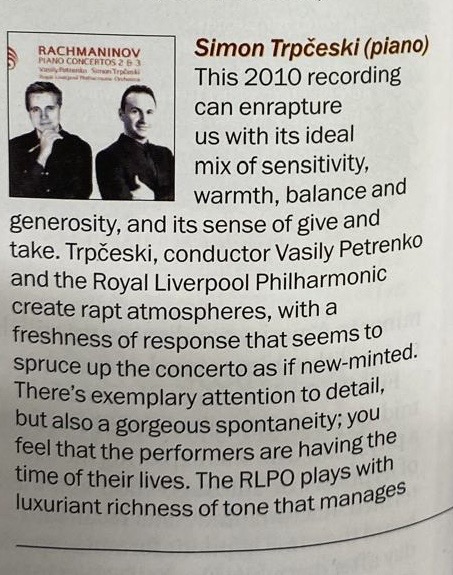Featured News

Scherzo: Simon Trpčeski Performs Prokofiev Piano Concerto No.3 with the Royal Philharmonic Orchestra & Vasily Petrenko in Madrid
The soloist for the occasion was the Macedonian Simon Trpčeski (Skopje, 1979), whom we had already admired in the same Ibermúsica series, also accompanied by Petrenko (with the Oslo Philharmonic on that occasion) six years ago. And Trpčeski generously displayed his many virtues. As we noted then, his instrument is superb, as are his attention to sound, the variety of nuances, and the intensity of his playing. The Macedonian imbues his interpretations with remarkable energy, resulting in a very special vibrato, although at times (the aforementioned dazzling allegro ) he slightly sacrifices the clarity of an articulation that is, in reality, exquisite. But his refined sensitivity allows him to unleash the full range of expression that Prokofiev demands, from the tranquil beginning to the electrifying voltage of the allegro.
Trpčeski displayed an exquisite leggiero touch , also frequently requested by Prokofiev, and great subtlety in his nuances. It is difficult to resist that vibrant energy upon which he builds a sweeping conclusion to the first movement. The central Theme with Variations demonstrated this delicacy in the leggierisimo (Variation I), but also allowed one to appreciate the capacity to offer forcefulness (Variation III) or mystery (Variation IV, with a truly delicatissimo , as Prokofiev demands, and an evanescent ppp at the end) and a suspended mixture of smile and almost mystery in the movement's final section. The final Allegro ma non troppo was another feast of rhythm and color , with a beautiful, more lyrical episode ( Meno mosso ) magnificently drawn by Petrenko. The grotesque atmosphere was superbly presented with the aforementioned four-note figures, and the ending, with its overwhelming trepidation, was received with predictable enthusiasm by the audience. Petrenko accompanied the soloist with remarkable precision and incisiveness, demonstrating a clear and fluid understanding. The orchestra responded with agility, remarkable blend, and rich sound. The woodwind soloists shone particularly brightly, but the entire ensemble delivered an enviable performance.
Trpčeski, always approachable and fluent in Spanish, briefly explained that he would next perform the Pepper Dance, a popular Macedonian dance that forms part of his commitment to promoting the folk music of his country (the Makedonissimo project, in which he participates with other compatriots). The short piece added even more color and rhythm to an afternoon they were already in control of. But this must have seemed like too little of an encore, and in another brief address, he announced another special treat dedicated to Alfonso Aijón (who received a well-deserved standing ovation). And what an encore it was! None other than the tremendous, tense, obsessive, and heart-wrenching Precipitato from Prokofiev's Seventh Sonata , presented with an intensity that leaves you on the edge of your seat.

BBC Music Magazine: Simon Trpčeski & Vasily Petrenko's Recording of Rachmaninoff Piano Concerto No.2 Selected Among the Best Recordings of the Work
This 2010 recording can enrapture us with its ideal mix of sensitivity, warmth, balance and generosity, and its sense of give and take. Trpčeski, conductor Vasily Petrenko and the Royal Liverpool Philharmonic create rapt atmospheres, with a freshness of response that seems to spruce up the concerto as if new-minted. There's exemplary attention to detail, but also a gorgeous spontaneity; you feel that the performers are having the time of their lives. The RLPO plays with luxuriant richness of tone that manages also to keep its transparency, aided by fine recorded sound. (Avie AV2192)






_B.%20Ealovega_S.Spirovski_KulturOp_3.jpg)
_B.Ealovega_KulturOp_4.jpg)

_B.Ealovega_KulturOp_6_C.jpg)